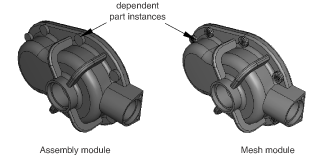How do I decide whether to create a dependent or an independent part instance? | ||
| ||
For example, Figure 1 illustrates an assembly of independent and dependent part instances. The pump housing is an independent part instance, and the eight bolts are dependent part instances. The figure on the left shows the assembly in the Assembly module. The figure on the right shows the assembly in the Mesh module. The user has meshed the part representing the bolt, and Abaqus/CAE associated the mesh with each dependent instance of the bolt.

You will find it more convenient to use dependent part instances when you use the linear or radial pattern tool to create a pattern of identical instances. When you mesh the original part, Abaqus/CAE applies the same mesh to each dependent instance in the pattern. In contrast, if you create a pattern of independent instances, you must mesh each instance individually.
Abaqus/CAE creates dependent instances by default. Unless your assembly contains only a few parts, it is recommended that you work with dependent instances because of the memory savings and the resulting performance gain.